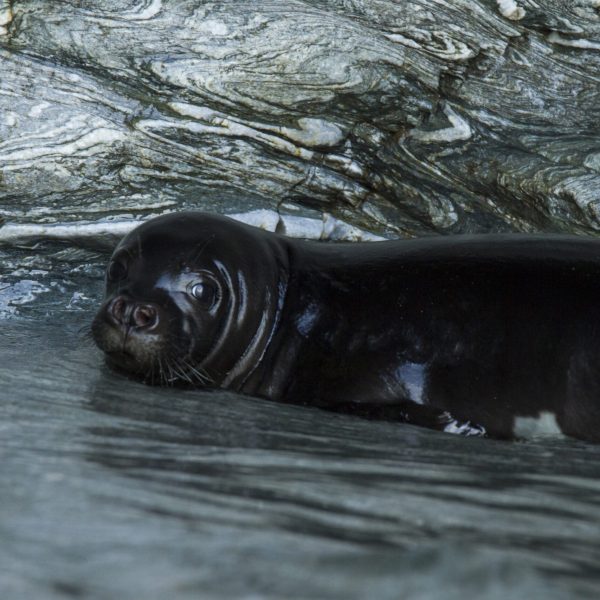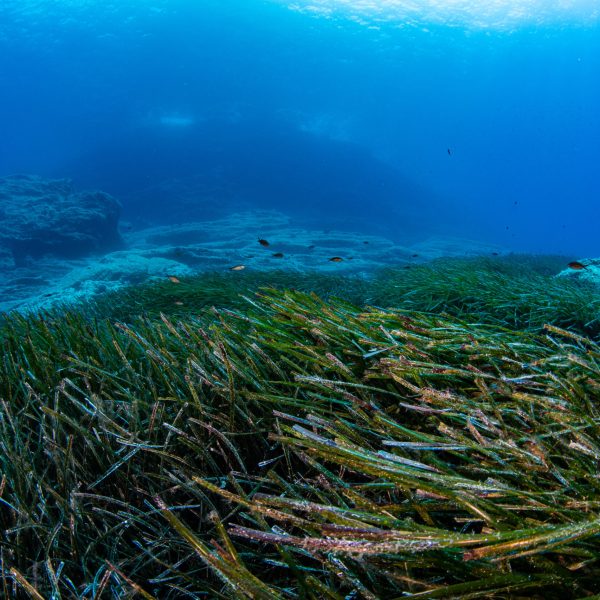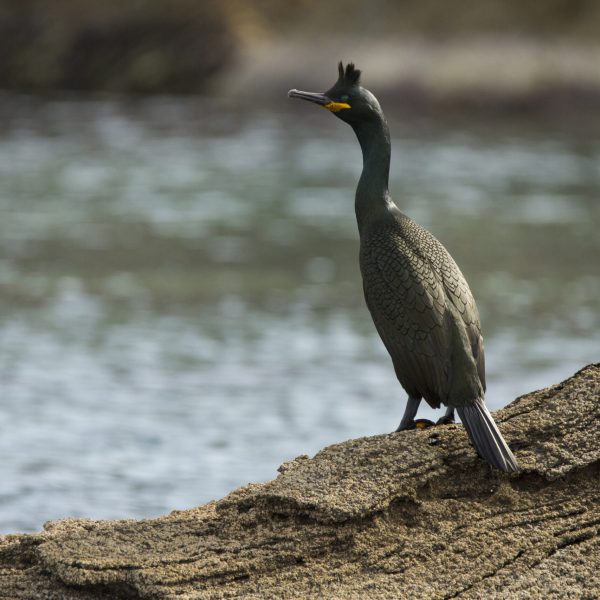The protected area
Gyaros / The protected area
Gyaros is an oasis of wild nature and life that few know about.
About 10% of the world population of the Mediterranean seal (Monachus monachus) live and breed on the island’s beaches and Yelkouan shearwaters (Puffinus yelkouan) nest in burrows at steep, rocky slopes, in the world’s second-largest colony for the species. Many more seabirds nest in the island. The Posidonia meadows and the coral “gardens” make up a life-giving ecosystem in which hundreds of organisms find refuge and “breathe” under the sea’s surface. The land hosts a rich bio-community, where only here will you meet the Black snake of Gyaros. Since 2011, the importance of the biodiversity of Gyaros has been recognized and the island and the marine area around it have been formally included in the pan-European network of Natura 2000 protected areas.

However, the effort to further protect the island did not stop there. The “Co-Management Committee of Gyaros” had a vision of creating a model marine protected area and proposed measures to preserve and manage the Gyaros ecosystem. The aim is to effectively protect the natural environment of the island and to support the wider area’s sustainable development. In 2019, the Greek state adopted these measures and Gyaros was formally established as a Marine Protected Area.
Based on existing greek legislation, the following apply to the Marine Protected Area:
Terrestrial zones
Terrestrial zone T.1
T1. In the entire area of Zone T1, the following are allowed:
a) Scientific research on the elements of the ecosystem on the condition that no degradation is resulted on the ecosystems and in the populations of the species of wild fauna and flora and the maximum degree of protection of nature and the landscape is ensured.
b) The implementation of projects and tasks aimed to improve, maintain and/or restore the characteristics of the ecosystem.
Terrestrial zone T.2
In the entire area of Zone T2, the regulations mentioned above for the case of Zone X1 apply and in addition, the following are allowed:
a) Actions and projects for the restoration and promotion of the historical site and the buildings and facilities, based on M inisterial D ecision ΔΠΑ/11131/17-9-2001 (Δ’ 772).
b) Visiting and guiding visitors solely during the day for the purpose of environmental education, nature observation and recreation. Through a decision of the Management Body of Protected Areas of the Cyclades, Central Aegean (current N.E.C.C.A.), it is possible to define specially configured routes/paths for the visitors. Overnight stays and outdoor camping are prohibited.
c) The disembarkation and boarding of visitors only from the pier that is located at the bay of prisons.
Terrestrial zone T.3
In the entire area of Zone T3, the regulations mentioned above for the case of Zone XT1 apply and in addition, the following are allowed:
a) Maintenance and restoration work of the existing buildings and paths.
b) Visiting and guiding visitors solely during the day for the purpose of environmental education, nature observation and recreation. Through a decision of the Management Body of Protected Areas of the Cyclades, Central Aegean (current N.E.C.C.A.), it is possible to define specially configured routes/paths for the visitors.
c) The installation of outdoor non-permanent structures, such as : information signs, rest areas, nature observatories.
Aquatic zones
Marine zone M1a
In the entire extent of zone M1, the regulations mentioned above for the case of Zone T1 apply. All forms of fishing are prohibited. M1a. In particular, in sub-zone M1a, the passage of vessels related to the actions permitted in zone T1 is allowed.
Marine zone M1b
In particular, in sub-zone M1b, the following are allowed: a) Carrying out organised recreational diving activities, based on the current legislation. b) The mooring of vessels exclusively on the specially placed moorings that will be located in the bays of the prison , but also in the bay of Fillada and only during the day. c) The passage of all vessels , with a speed of up to 10 knots.
Marine zone M2
In the entire extent of zone M2, the regulations mentioned above for the case of Zone T1 apply. All forms of fishing are prohibited. All vessels, except those carrying dangerous cargo (toxic, waste, fuel, etc.), are allowed to enter and pass through this zone at a speed of up to 10 knots.
Marine zone M3
In the entire extent of zone M3, the regulations mentioned above for the case of Zone T1 apply. All forms of fishing are prohibited. All vessels, except those carrying dangerous cargo (toxic, waste, fuel, etc.), are allowed to enter and pass through this zone at a speed of up to 10 knots.
Natura 2000 area
The protected area of the Natura 2000 network, SAC-SPA “Gyaros Island and Marine Zone” (Code: GR4220033), has a total area of 260.37 km2, of which 93.2% corresponds to the marine area around the island of Gyaros.
An abundance of flora and fauna species has been recorded in Gyaros:
- about 240 species and subspecies of flora, including the endemic species of the western Cyclades Fritillaria obliqua subsp. tuntasia.
- 2 protected mammal species, the Mediterranean monk s eal and the Common Bottlenose Dolphin.
- more than 30 species of avifauna – important breeding species are the Yelkouan shearwater, the European shag, the Bonelli’s eagle, the Eleonora’s falcon and the Long-legged buzzard.
- 5 species of reptiles, including the Black Gyaros snake, a species whose population can only be found in Gyaros in Greece.
- at least 45 species of invertebrates – about 23 species of beetles, 5 species of centipedes, 8 species of spiders, 1 species of scorpion and 20 species of land molluscs, including 19 land snails and 1 freshwater snail.
- a multitude of fish species, such as Mediterranean parrotfish, Goldblotch grouper, Salema porgies, Dusky spinefoot, Saddled seabreams, Common two-banded sea breams and Striped red mullets.
A total of sixteen (16) natural habitat types are recorded in the protected area, of which 13 are from Annex I of Directive 92/43/EEC and three (3) are of national importance (National Cadastre and Mapping Agency S.A., 2016):
- 9620: River bed without vegetation (national interest)
- 9320: Olea and Ceratonia forests
- 8260: Adiantetalia: Acrocladio-Adiantetum in slate (national interest)
- 8250: Rocky substrate not covered by vegetation (national interest)
- 6220*: Pseudo-steppe with grasses and annuals of the Thero-Brachypodietea
- 5420: Sarcopoterium spinosum phryganas
- 5330: Thermo-Mediterranean and pre-desert scrub
- 3140: Hard oligo-mesotrophic waters with benthic vegetation of Chara
- 1430: Halo-nitrophilous scrubs (Pegano-Salsoletea)
- 1410: Mediterranean salt meadows (Juncetalia maritimi)
- 1240: Vegetated sea cliffs of the Mediterranean coasts with endemic Limonium
- 1160: Large shallow inlets and bays
- 1170: Reefs
- 1110: Sandbanks which are slightly covered by sea water all the time
- 8330: Submerged or partially submerged sea caves
-
1120*: Posidonia beds (Posidonion oceanicae)
* priority habitat type
The underwater wealth of Gyaros (Source: Y. Issaris)
You can learn more about the Gyaros Marine Protected Area from videos created within the CYCLADES LIFE program.








